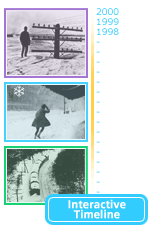 |
|||||||||||||||||||||||||||||||
|
Winter Storms
In-Depth Over North America, strong winds blowing from west to east usually move a winter storm quickly across the continent. That's why a winter storm rarely lasts more than a day in one area. One exception to this rule occurs downwind of major bodies of water like the Great Lakes. If a strong, cold wind blows over a great length of unfrozen water, the air can acquire substantial amount of moisture. This moisture turns into heavy snow when it reaches land. These "lake-effect" snowstorms can last for many days and dump huge amounts of snow. A lake-effect snowstorm in November 2000 dumped 25" of snow in 24 hours on Buffalo, NY. At the storm's peak, it dumped 3" of snow per hour! The classic winter storm is called a "Nor'easter." Throughout history, there have been several notable winter storms. Explore their history with a Winter Storm Timeline:
People love to tell stories about weather, and how the storm that they remember was the worst there ever was. Well, some of those stories are actually true, if slightly exaggerated. Discover winter storms where the snow was as high as the radio tower, the wind actually blew cows from one pasture to another, and the time when� Click on the Interactive Timeline to see the history of winter storms over the last three centuries. The Flash Plug-in is required to view the Interactive Timeline. If you don't have it, click here to download it for free. |
||||||||||||||||||||||||||||||

